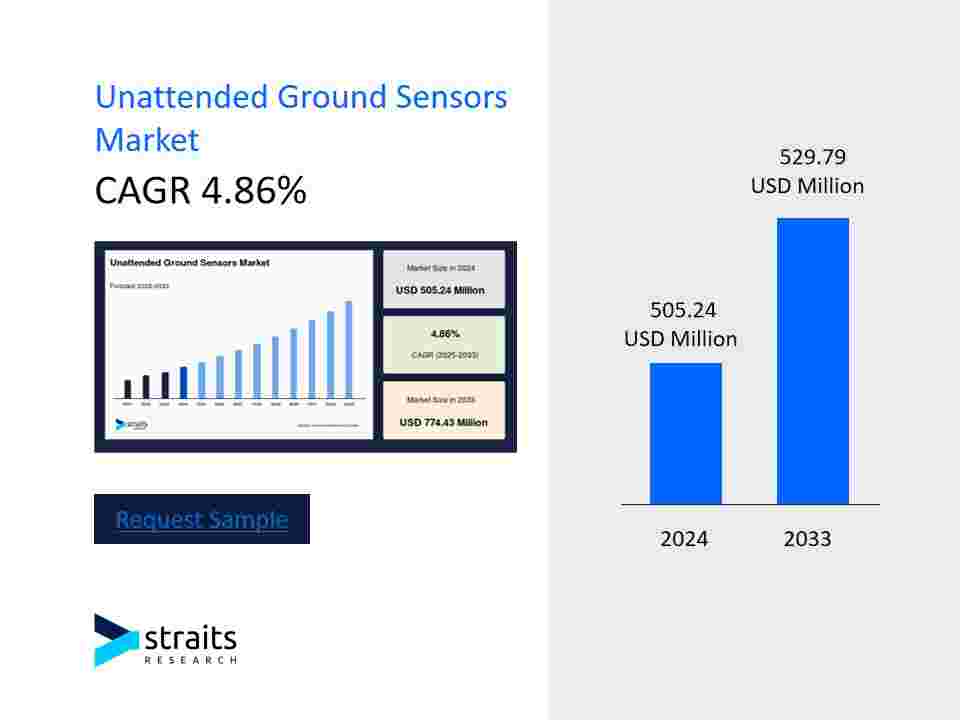Unattended ground sensors (UGS) have become indispensable tools in modern defense and security operations, offering versatile and remote surveillance capabilities without the need for continuous human presence. These sensors detect, monitor, and track movement in diverse terrains and conditions, providing critical real-time intelligence for military, border security, infrastructure protection, and environmental monitoring applications worldwide. With rapid technological advances, UGS systems today are smarter, more energy-efficient, and integrated with AI for unprecedented situational awareness.
According to Straits Research, “The global unattended ground sensors market size was valued at USD 505.24 million in 2024 and is estimated to grow from USD 529.79 million in 2025 to reach USD 774.43 million by 2033, growing at a CAGR of 4.86% during the forecast period (2025–2033).” Rising geopolitical tensions, increased homeland security investments, and breakthroughs in sensor technologies are key growth drivers boosting adoption across regions.
Technological Advancements and Features
Leading UGS solutions in 2025 incorporate cutting-edge technologies enhancing detection accuracy, operational longevity, and data integration:
-
Multi-Sensor Fusion: Modern UGS blend seismic, acoustic, infrared, magnetic, and radar sensors to detect and classify a wide range of targets including footsteps, vehicles, drones, and animal movements. This fusion reduces false alarms and improves reliability even in complex environments.
-
AI-Based Analytics: Embedded machine learning algorithms analyze sensor outputs in real-time to categorize threats, estimate distance and trajectory, and prioritize alerts for command centers, thus reducing operator workload and response times.
-
Extended Battery Life and Energy Harvesting: Advances in low-power electronics, solar charging, and energy-efficient communication extend sensor lifetimes from weeks to months, enabling long-term deployment in remote or hostile areas.
-
Wireless Mesh Networks: Sensors communicate via robust, self-healing mesh networks transmitting data securely to centralized hubs, supporting large-scale surveillance and rapid redeployment.
-
Miniaturization and Concealability: Compact, camouflaged designs facilitate covert placement, essential for tactical operations, border monitoring, and infrastructure protection.
-
Interoperability: UGS systems increasingly integrate with broader defense and security infrastructure including drone reconnaissance, radar surveillance, and command-and-control platforms for holistic situational awareness.
Key Players and Regional Dynamics
The market is led by prominent defense contractors and niche specialists enhancing capabilities through R&D and strategic partnerships:
-
BAE Systems (UK/US): Develops advanced UGS for reconnaissance and perimeter protection integrated with sensor fusion and AI analytics enhancing battlefield intelligence.
-
Raytheon Technologies (US): Offers multi-modal sensor networks focused on border security and critical infrastructure protection with emphasis on long endurance and secure communication.
-
Elbit Systems Ltd. (Israel): Specializes in compact, portable UGS tailored for diverse operational theaters, emphasizing rapid deployment and integration with Israeli and international defense forces.
-
Lockheed Martin Corporation (US): Provides US military with next-gen UGS solutions linked to autonomous platforms and drone systems, optimized for precision targeting and early warning.
-
Leonardo S.p.A. (Italy) and Saab AB (Sweden): European innovators focusing on multi-sensor UGS networks supporting NATO and EU defense initiatives.
-
Asia-Pacific: China and India lead regional adoption driven by large border monitoring needs and rising defense budgets, supported by government modernization programs.
-
North America: The US remains the largest UGS market due to major defense spending, border security programs, and homeland security investments deploying integrated sensor networks.
-
Europe: Heightened geopolitical tension and critical infrastructure protection initiatives fuel demand for UGS in Western and Eastern Europe.
-
Middle East, Latin America, and Africa: Emerging adopters focus on securing extensive borders and critical facilities with modular UGS services adapted to local terrain complexities.
Emerging Trends and Growth Factors
-
Increasing reliance on autonomous sensor networks and AI-driven analytics redefines surveillance paradigm, enabling faster, more actionable intelligence collection.
-
UGS are expanding beyond military and border applications into environmental monitoring, wildlife tracking, and disaster management in both developed and developing countries.
-
Improved sensor miniaturization and energy harvesting increase feasibility of persistent monitoring in remote and inaccessible regions with minimal human intervention.
-
Government and defense investments target UGS interoperability, enabling seamless data exchange across platforms and integration with other security assets.
-
Rising asymmetric threats and rising counter-terrorism budgets place UGS as critical enablers of national and asset security in volatile regions.
-
Partnerships between technology providers and defense agencies accelerate R&D cycles and tailor devices for emerging security requirements.
Recent Industry News
-
Applied Research Associates launched “Pathfinder” wireless unattended ground sensors with enhanced UI integration into Tactical Assault Kit platforms enabling simplified global management, showcased at FIDAE 2024.
-
Bertin Exensor, collaborating with EPE Trusted to Protect, secured a contract with New Zealand Ministry of Defence for Flexnet UGS systems enhancing reconnaissance and surveillance capabilities.
-
Elbit Systems debuted upgraded UGS featuring improved multispectral sensing and AI-driven data fusion at a 2025 defense expo in Europe.
-
Textron Systems enhanced seismic and acoustic sensors to optimize detection range and accuracy, deployed widely along U.S. border security zones.
-
Northrop Grumman advanced integration of UGS with autonomous drone command networks, expanding real-time battlefield situational awareness.
-
Changes in global tensions and rising asymmetric warfare fuel continued procurement of UGS systems across Asia-Pacific and European defense forces.
Conclusion
Unattended ground sensors represent a vital force multiplier in modern security and defense ecosystems, blending sophisticated sensing technology, AI analytics, and enduring autonomous operation. As geopolitical dynamics and security challenges evolve, UGS technology offers scalable, reliable, and covert recognition capabilities. Its expanding adoption across multiple sectors suggests a robust growth trajectory through 2033 with continuous innovation spearheading next-generation surveillance systems.
Summary
Unattended ground sensors harness AI and multi-sensor fusion to deliver dependable autonomous surveillance and threat detection. Driven by rising security concerns and technological advances, UGS systems expand globally across defense, border security, and environmental monitoring. The future points to greater integration and smarter sensor networks enhancing real-time situational awareness.




